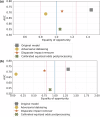A fair individualized polysocial risk score for identifying increased social risk in type 2 diabetes
- PMID: 39369018
- PMCID: PMC11455957
- DOI: 10.1038/s41467-024-52960-9
A fair individualized polysocial risk score for identifying increased social risk in type 2 diabetes
Abstract
Racial and ethnic minorities bear a disproportionate burden of type 2 diabetes (T2D) and its complications, with social determinants of health (SDoH) recognized as key drivers of these disparities. Implementing efficient and effective social needs management strategies is crucial. We propose a machine learning analytic pipeline to calculate the individualized polysocial risk score (iPsRS), which can identify T2D patients at high social risk for hospitalization, incorporating explainable AI techniques and algorithmic fairness optimization. We use electronic health records (EHR) data from T2D patients in the University of Florida Health Integrated Data Repository, incorporating both contextual SDoH (e.g., neighborhood deprivation) and person-level SDoH (e.g., housing instability). After fairness optimization across racial and ethnic groups, the iPsRS achieved a C statistic of 0.71 in predicting 1-year hospitalization. Our iPsRS can fairly and accurately screen patients with T2D who are at increased social risk for hospitalization.
© 2024. The Author(s).
Conflict of interest statement
The authors declare no competing interests.
Figures








Update of
-
A Fair Individualized Polysocial Risk Score for Identifying Increased Social Risk in Type 2 Diabetes.Res Sq [Preprint]. 2023 Dec 6:rs.3.rs-3684698. doi: 10.21203/rs.3.rs-3684698/v1. Res Sq. 2023. Update in: Nat Commun. 2024 Oct 5;15(1):8653. doi: 10.1038/s41467-024-52960-9. PMID: 38106012 Free PMC article. Updated. Preprint.
References
-
- C. D. C. Type 2 Diabetes. Centers for Disease Control and Preventionhttps://www.cdc.gov/diabetes/basics/type2.html (2022).
-
- Social Determinants of Health. https://health.gov/healthypeople/priority-areas/social-determinants-health.
-
- Marmot, M. et al. Closing the gap in a generation: health equity through action on the social determinants of health. Lancet372, 1661–1669 (2008). - PubMed
-
- Bryant, T., Daiski, I., Lines, E. & Others. Type 2 diabetes: poverty, priorities and policy: the social determinants of the incidence and management of Type 2 diabetes (Toronto, Ontario, Canada: York University School of Health Policy and Management, 2010).
Publication types
MeSH terms
Grants and funding
LinkOut - more resources
Full Text Sources
Medical

